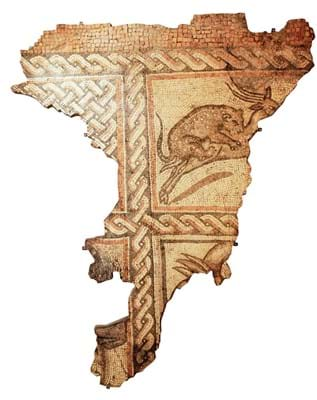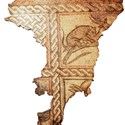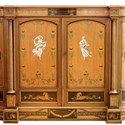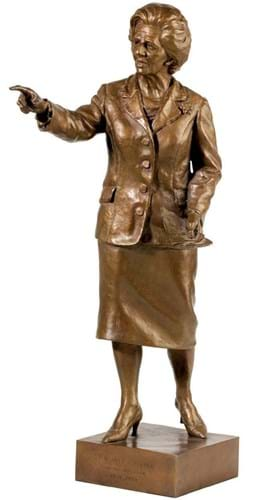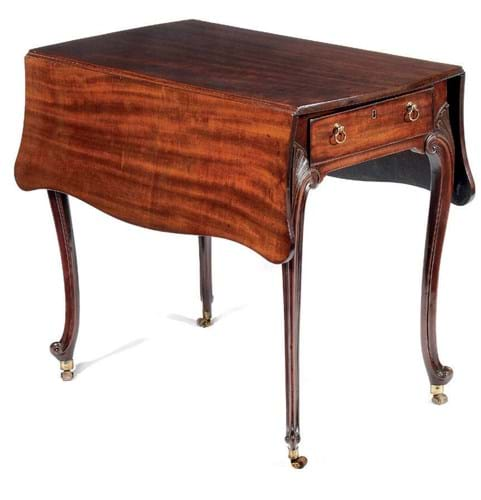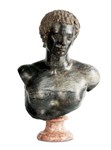These included, at Duke’s (22% buyer’s premium) Dorchester sale on September 6, a large fragment of a Romano-British mosaic dated to the 3rd or 4th century. Measuring 7ft 9in x 6ft 3in (2.37 x 1.90m) at its maximum dimensions, a central panel depicted a leopard attacking a gazelle.
It was part of the paving at a villa in Dewlish, Dorset, a site known since 1740 when a storm uprooted a tree trunk to reveal a mosaic. More scientific digs took place in 1969 and 1979.
The fragment at Duke’s was entered from an important local collection with an estimate of £10,000-20,000. There was institutional interest but it finally went to a Continental bidder at £30,000.
The highest bid, however, was for a much more modern work, an unnumbered bronze maquette prototype for Ivor Roberts-Jones’ famous 1971 statue of Sir Winston Churchill in Parliament Square.
The 20in (51cm) tall bronze, marked Meridian Bronze, London, is of a type which comes up at auction occasionally and was estimated at £30,000-50,000. It sold to a UK buyer at £78,000, which auctioneer Guy Schwinge believes to be a new high. “A similarly sized bronze maquette sold at Bonhams in June for a premium-inclusive £90,000,” he said. “With premium and VAT our buyer would have paid more than £100,000.”
The maquette had come from the estate of the late Sir Edward du Cann (1924-2017), a senior Tory politician in the 1970s and 1980s whose financial affairs cast a cloud over his later years.
Obituaries of the colourful onetime MP for Taunton reflected that his defining role had been to help depose Ted Heath and give the world Margaret Thatcher.
“The money is there if the pieces – and the prices – are right Ben Brown, head of furniture, Dreweatts
Thatcher’s admirers
These days it may be hard to remember that Lady T was sufficiently popular to win three general elections. Du Cann’s two bronzes of the Iron Lady suggest that she has her fervent admirers today.
Both signed by Antony Dufort, a 14in (36cm) tall bust made £5000 – ten times the lower estimate – while a 19in (49cm) tall maquette Dufort made for the 7ft 3in ( 2.21m) statue in the Commons took £24,000 (estimate £2000-3000). Although intended as an edition of nine, it was, Dufort says, the only one made.
The fourth du Cann bronze was a 2ft (61cm) tall figure of a standing Clement Attlee, against who the young du Cann stood (in vain, of course) for the West Walthamstow seat in the 1951 General Election. The estimate of £200-400 and winning bid of £650 reflected it being a modest piece ascribed only to the ‘English School’ rather than a judgment on Attlee’s career.
Best of the 126 pieces of furniture in the 880-lot sale was an early George III mahogany library cabinet on chest. A manageable 6ft 3in tall and 3ft 8in wide (1.91 x 1.11m) and with mirrored glass doors, it quadrupled hopes at £6500.
A mid-19th century, Louis XV-style walnut and marquetry credenza was a superb example but, as these once hugely popular pieces struggle to get away these days, it was estimated at just £500-1000. However, it was stamped Levien, undoubtedly for the Johann Martin Levien (1811-71), the German-born, globe-trotting maker who settled in London in 1844, obtaining the Royal Warrant just two years later.
That raised Continental interest and the credenza sold to a European bidder at £3600.
Donnington selection
Furniture was very much to the fore at the small but carefully curated sort of sale which Dreweatts (24% buyer’s premium) has adopted as a policy. Around 80% of the 161 lots offered on September 5 got away to total £340,000.
Five pieces took five-figure bids although (at least according to vendors’ memories) these were considerably less than they had cost 20-30 years ago.
Pembroke tables – elegant, and so fashionable in the boom years – have been among the victims of changing fashion. However, the example at Donnington Priory with moulded cabriole tapering legs surmounted by anthemion and scroll carved pilasters was attributed to Thomas Chippendale.
Short of an actual receipt, all the research by Ben Brown, head of Dreweatts’ furniture department, pointed to it having been made at the great man’s workshop.
Estimated at £5000-7000 it went to a private bidder at £14,000.
A mahogany library drum table dated c.1790 and attributed to Gillows, was also a superb example of its type. Related examples took premium inclusive sums of £56,400 and £35,850 at Christie’s in 2000 and 2003 respectively. This example pitched at £8000-12,000 went to another private buyer at £17,000.
Sharing the top honours were an English and a French classic – a c.1770 mahogany breakfront library bookcase and a Louis XVI mahogany and gilt bronze-mounted console desserte.
The 7ft 11in tall, 7ft 7in wide (2.42 x 2.33m) bookcase was of typical restrained grandeur and of sufficiently high quality to include a provenance to HW Kiel at the Grosvenor House Fair in 1975 and to be given an estimate (although apparently unreached) of £50,000-70,000 at Sotheby’s in June 2004.
At Donnington Priory it was pitched at a more attractive £8000- 12,000 and sold to a private buyer at £19,000.
The c.1785 console desserte – a 5ft 5in (1.64m) wide breakfront sideboard – was in the manner of preeminent Paris cabinet maker Adam Weisweiler. Pitched at £4000-6000 it also made £19,000, going to a French buyer.
“The money is there if the pieces – and the prices – are right,” said auctioneer Ben Brown.


